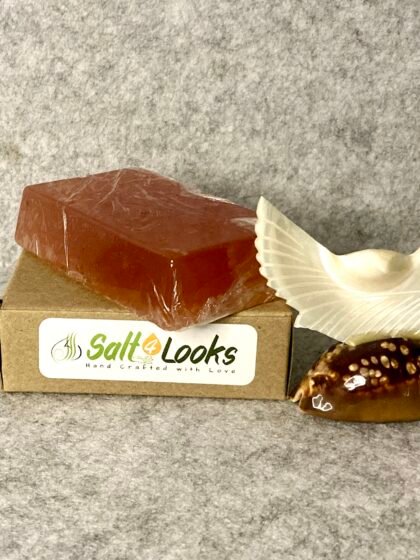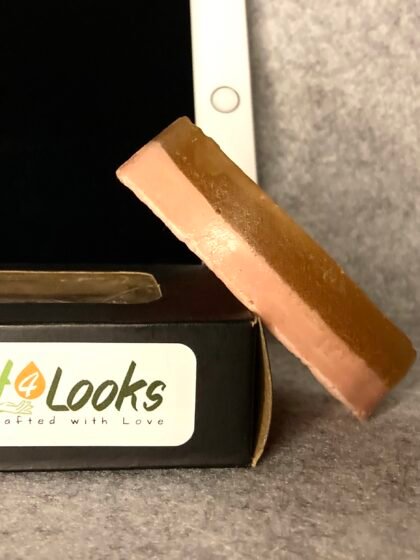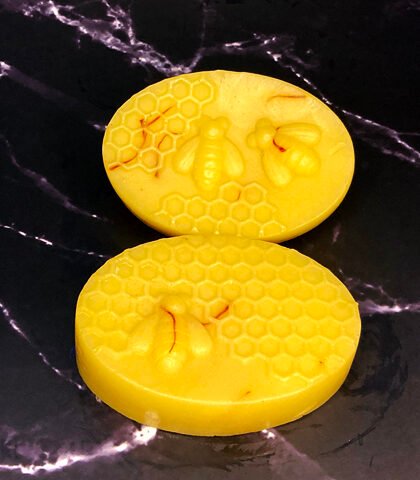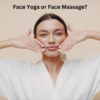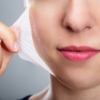- Empty cart.
- Continue Shopping
Hyperpigmentation Acne: Causes and Treatment
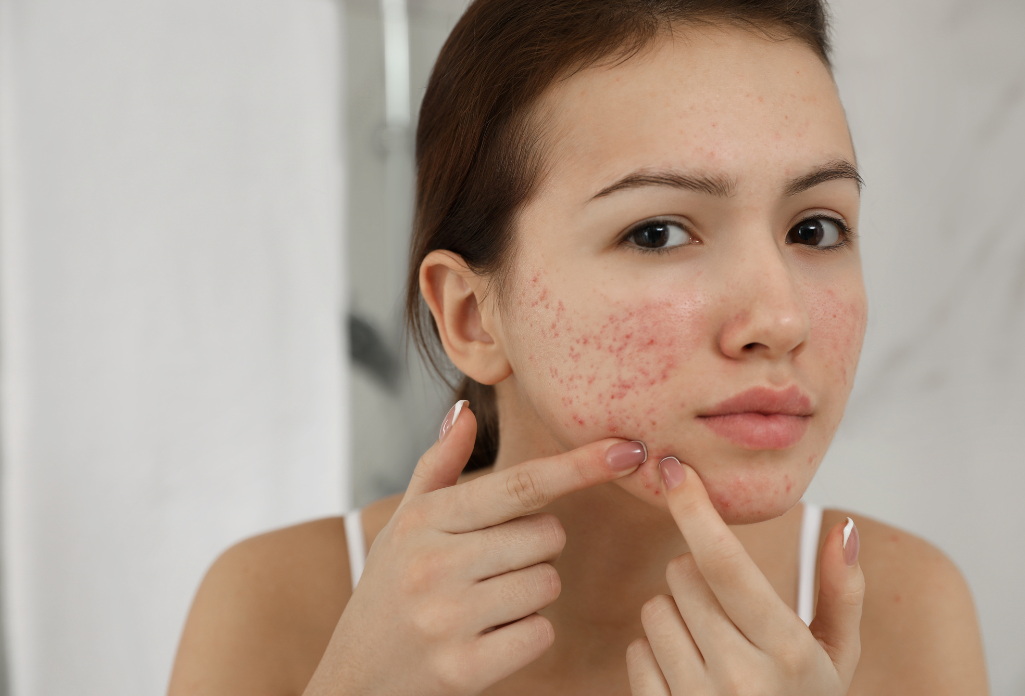
Hyperpigmentation in acne-prone skin refers to the darkening or discoloration of the skin that occurs after an acne breakout. It is a common concern among individuals who have experienced acne, and it can persist even after the acne has healed.
Hyperpigmentation develops as a result of an overproduction of melanin, the pigment responsible for the color of our skin, hair, and eyes. When acne lesions or breakouts occur, inflammation triggers the skin to produce excess melanin in the affected areas, leading to the appearance of dark spots or patches.
There are different types of hyperpigmentation associated with acne-prone skin:
-
- Post-inflammatory hyperpigmentation (PIH): This is the most common type of hyperpigmentation resulting from acne. It appears as flat, darkened spots or patches on the skin and can range in color from red to brown or black. PIH occurs due to the overproduction of melanin in response to inflammation caused by acne.
-
- Post-inflammatory erythema (PIE): Although not technically a form of hyperpigmentation, PIE refers to the red or pink discoloration that remains after an acne breakout. It is caused by blood vessel dilation and can persist for weeks to months.
-
- Melasma: Melasma is a type of hyperpigmentation that is not directly related to acne but can occur alongside it. It typically appears as brown or grayish-brown patches on the face, especially on the cheeks, forehead, and upper lip. Melasma is often triggered by hormonal changes, sun exposure, and genetic factors.
Do you need to change your lifestyle to deal with it?

While lifestyle changes alone may not cure hyperpigmentation caused by acne, they can play a supportive role in improving the condition and preventing further pigmentation issues. Here are some lifestyle recommendations that can help:
-
- Maintain a consistent skincare routine: Establish a gentle skincare routine and be consistent with it. Cleanse your face twice a day using a mild cleanser suitable for acne-prone skin. Avoid harsh scrubbing or aggressive exfoliation, as it can worsen inflammation and pigmentation.
-
- Protect your skin from the sun: Sun exposure can darken hyperpigmentation and make it more challenging to fade. Always apply a broad-spectrum sunscreen with at least SPF 30 before going outdoors, and reapply it every two hours. Wear protective clothing, hats, and sunglasses to minimize sun exposure.
-
- Avoid picking or popping acne: Picking or popping acne lesions can lead to further inflammation and increase the risk of hyperpigmentation. It may also result in scarring. Resist the temptation to touch or squeeze your pimples.
-
- Maintain a healthy diet: Eating a balanced diet rich in fruits, vegetables, whole grains, and lean proteins can support overall skin health. Some nutrients, such as vitamins C and E, zinc, and antioxidants, can aid in the healing and rejuvenation of the skin.
-
- Stay hydrated: Drinking an adequate amount of water throughout the day helps keep your skin hydrated and supports its natural healing processes.
-
- Manage stress: Chronic stress can exacerbate acne and skin conditions. Practice stress management techniques such as exercise, meditation, deep breathing, or engaging in activities you enjoy to help reduce stress levels.
-
- Get enough sleep: Aim for 7-9 hours of quality sleep each night. Sufficient sleep helps promote healthy skin and aids in its repair and rejuvenation processes.
-
- Avoid excessive makeup or irritating products: Heavy or pore-clogging makeup can worsen acne and potentially lead to more pigmentation issues. Choose non-comedogenic or oil-free products, and remove makeup gently before bed. Avoid using harsh skincare products or those containing irritating ingredients that can exacerbate inflammation and pigmentation.
-
- Do Facial yoga regularly:
Facial yoga can be beneficial for treating acne and pigmentation . These skin conditions are often caused by hormonal imbalances, stress, and toxins . Practicing regular facial yoga exercises can help detoxify the skin, stimulate and regulate hormonal function, and increase the amount of oxygenated blood in the face, resulting in a rosy glow and preventing pimples and acne. It is important to note that beauty is both an external and internal process, and facial yoga can contribute to improving overall health and well-being.
Remember, while lifestyle changes can support the healing process, it’s also important to take proper care of your skin and also consult with a dermatologist for a comprehensive approach to treating and managing acne hyperpigmentation.
How to take care of your skin while having this problem?

Treating hyperpigmentation associated with acne can be challenging, but several options can help to improve the condition. To deal with acne hyperpigmentation, here are some strategies you can try:
Patience and time: Hyperpigmentation can take several months to fade naturally. While waiting for it to resolve on its own, it’s essential to focus on preventing new breakouts and protecting your skin from further damage.
Gentle skincare routine: Establish a gentle skincare routine that includes cleansing your face twice a day using a mild cleanser suitable for acne-prone skin. Avoid harsh scrubs or aggressive exfoliation methods, as they can worsen inflammation and pigmentation.
Sun protection: Protecting your skin from the sun is crucial as UV exposure can darken and prolong hyperpigmentation. Apply a broad-spectrum sunscreen with at least SPF 30 every day, even on cloudy days, and reapply it every two hours when exposed to direct sunlight.
Topical treatments: Look for topical treatments that contain ingredients known for their skin-lightening properties, such as 2% hydroquinone, retinoids, kojic acid, azelaic acid, vitamin C, or niacinamide. These ingredients can help reduce hyperpigmentation over time. Follow the instructions on the product and be consistent with their use.
Chemical peels: Chemical peels, performed by a dermatologist, can help accelerate the fading process of hyperpigmentation. These peels use chemical solutions to exfoliate the skin and promote the growth of new, less pigmented skin. They can be effective in treating hyperpigmentation, but they should be done under professional supervision.
Laser treatments: Laser therapies, such as IPL (intense pulsed light) or fractional laser resurfacing, can target hyperpigmentation and stimulate collagen production. Laser treatments work by breaking down excess melanin in the skin, leading to a more even skin tone. However, these procedures should be performed by a trained professional.
Makeup and concealers: If you want to conceal hyperpigmentation temporarily, you can use makeup products specifically designed to cover discoloration. Look for foundations or concealers with high coverage and color-correcting properties to help camouflage the hyperpigmented areas.
Remember, it’s essential to be consistent with your chosen treatment methods and give them time to work. It’s also advisable to consult with a dermatologist who can evaluate your specific condition and recommend the most suitable treatment options for your acne hyperpigmentation.
DIY Face pack to cure Hyperpigmentation Acne
While face packs alone may not cure hyperpigmentation caused by acne, they can be used as a complementary treatment to support the fading process and improve the overall appearance of the skin. Here are a few face pack suggestions that may help with hyperpigmentation:
Turmeric and Honey Face Pack:
-
- Mix 1 teaspoon of turmeric powder with 2 teaspoons of raw honey.
-
- Apply the mixture to your face and leave it on for 15-20 minutes.
-
- Rinse off with lukewarm water. Turmeric has natural skin-lightening properties, while honey helps soothe and moisturize the skin.
Aloe Vera and Lemon Juice Face Pack:

-
- Extract fresh aloe vera gel from an aloe leaf.
-
- Mix 1 teaspoon of aloe vera gel with 1 teaspoon of freshly squeezed lemon juice.
-
- Apply the mixture to your face and leave it on for 15-20 minutes.
-
- Rinse off with cool water. Aloe vera has soothing and healing properties, while lemon juice contains natural bleaching agents that can help lighten hyperpigmentation.
Papaya and Yogurt Face Pack:
-
- Mash a ripe papaya into a smooth paste.
-
- Mix 2 tablespoons of papaya paste with 1 tablespoon of plain yogurt.
-
- Apply the mixture to your face and leave it on for 15-20 minutes.
-
- Rinse off with lukewarm water. Papaya contains enzymes that can help exfoliate the skin gently and promote a more even complexion, while yogurt helps nourish and hydrate the skin.
Oatmeal and Milk Face Pack:

Grind 2 tablespoons of oatmeal into a fine powder.
-
- Mix the oatmeal powder with enough milk to form a paste.
-
- Apply the mixture to your face and leave it on for 15-20 minutes.
-
- Rinse off with water, gently massaging the paste in circular motions. Oatmeal acts as a gentle exfoliant, helping to remove dead skin cells and promote a brighter complexion, while milk can provide hydration and nourishment to the skin.
Easiest Solution to this problem with Salt4Looks Products
We have two miracle products with us. These two products will solve this problem within very short period of time depending on the skin condition and without any hazard. The first one is Ubtan Powder and the second one is Kumkumadi oil.
Ubtan Powder: How it works
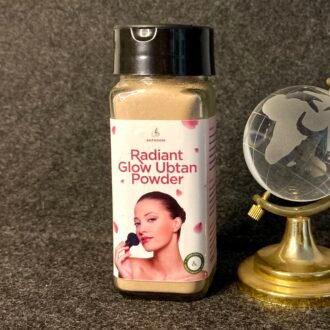 Our Ubtan powder offers gentle exfoliation, brightening, deep cleansing, nourishment, anti-inflammatory, antioxidant, toning, and glow-enhancing benefits for the skin, resulting in a smoother, brighter, and healthier complexion. Our Royal Ubtan powder is a perfect blending of 17 herbs and minerals. Mix this powder with Curd (1:2 ratio) and make a paste. Apply this on your face and keep it for 10-15 minutes. Wash your face with normal water and see the magic . You will find that your acne breakouts has been reduced/stopped only after few uses. But there may be few pigmentation/dark spots and to remove those spots, you need to use Kumkumadi oil.
Our Ubtan powder offers gentle exfoliation, brightening, deep cleansing, nourishment, anti-inflammatory, antioxidant, toning, and glow-enhancing benefits for the skin, resulting in a smoother, brighter, and healthier complexion. Our Royal Ubtan powder is a perfect blending of 17 herbs and minerals. Mix this powder with Curd (1:2 ratio) and make a paste. Apply this on your face and keep it for 10-15 minutes. Wash your face with normal water and see the magic . You will find that your acne breakouts has been reduced/stopped only after few uses. But there may be few pigmentation/dark spots and to remove those spots, you need to use Kumkumadi oil.
Kumkumadi Oil
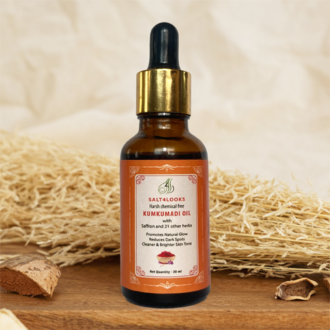 Kumkumadi Oil also known as Kumkumadi Tailiam is considered a ‘Miraculous Elixir’ that makes your skin glow like gold. The name Kumkumadi comes from its key ingredients Saffron, known as Kumkuma in Sanskrit. It is an Ayurvedic Remedy that aims towards Diminishing Blemishes, treating dry skin, correcting complexion and other skin issues. Kumkumadi oil is an herbal blend of 21 herbs including saffron, sandalwood, Indian Madder (Manjistha) and Licorice root extract (Madhuyashtika).It lightens stubborn Dark Circles ,improve your skin texture, rejuvenates it, and brings out your Skin’s Natural Glow. Apply Salt4looks’ Kumkumadi oil as face serum after cleansing and toning your face. Apply 4-5 drops of this oil on your face by gentle massage until it is fully absorbed. Allow it to work overnight for best results. You can even mixed it with carrier oil or with your night cream for massaging purpose.
Kumkumadi Oil also known as Kumkumadi Tailiam is considered a ‘Miraculous Elixir’ that makes your skin glow like gold. The name Kumkumadi comes from its key ingredients Saffron, known as Kumkuma in Sanskrit. It is an Ayurvedic Remedy that aims towards Diminishing Blemishes, treating dry skin, correcting complexion and other skin issues. Kumkumadi oil is an herbal blend of 21 herbs including saffron, sandalwood, Indian Madder (Manjistha) and Licorice root extract (Madhuyashtika).It lightens stubborn Dark Circles ,improve your skin texture, rejuvenates it, and brings out your Skin’s Natural Glow. Apply Salt4looks’ Kumkumadi oil as face serum after cleansing and toning your face. Apply 4-5 drops of this oil on your face by gentle massage until it is fully absorbed. Allow it to work overnight for best results. You can even mixed it with carrier oil or with your night cream for massaging purpose.
Conclusion: Remember to perform a patch test before applying any face pack to ensure that you are not allergic or sensitive to any of the ingredients. Additionally, it’s important to consult with a dermatologist for a comprehensive approach to treating and managing acne hyperpigmentation. They can provide personalized advice and recommend the most suitable treatments for your specific condition.

